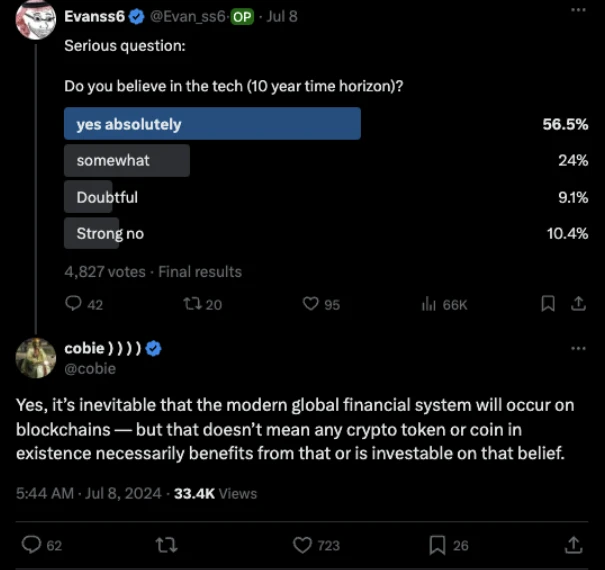Buyers are becoming more institutionalized, Ethereums old dream and new reality
ต้นฉบับแปล: TechFlow
Ethereum’s continued development over the past decade has spawned a variety of use cases for ETH, and different views on its value. Crypto investors who have experienced the rise in ETH prices may view it as “ultrasonic money.” Technology purists may view it as a trusted, neutral global computer. New players may view it as “digital oil” that powers decentralized, open-source app stores.
Investment Case for Ethereum: What is the investment value of Ethereum?
Ethereum’s value lies in its flexibility and ability to support applications more complex than simple value transfer. Ethereum has the largest and most active community of software contributors who implement upgrades to enhance the platform’s functionality. These developers are not only focused on the continued relevance of the platform, but are also committed to contributing to a platform that can adapt and scale, thereby laying a solid foundation for assets and activities now and in the future. Currently, the most popular applications on Ethereum include stablecoins (payment tokens pegged to the US dollar), decentralized finance (rebuilding traditional financial services such as lending on the blockchain), and tokenization (issuing financial assets on the blockchain).
When applications run on Ethereum, ether tokens are used as the currency required to conduct transactions in the Ethereum ecosystem. These ethers are consumed and removed from circulation when paying transaction fees, which may reduce the supply of ether as the platform usage grows. Therefore, investing in ether expresses a view that more applications will be built on Ethereums open and permissionless programming infrastructure, with the goal of attracting more users and revenue, and expanding the scope of ethers use as a currency.
แหล่งที่มา: iShares
We believe that for Ethereum adoption to continue to increase, there needs to be continued buy-in from new market participants who have unique perspectives on the value of ETH. The marginal buyers of ETH may not share the same ideological leanings as crypto natives, and we should accept that. As we move into the post-ETF timeline and institutional adoption increases, we expect that applications built on Ethereum with institutional appeal will benefit the most from traffic, fees, and ultimately price.
The approval of an ETH ETF will have a long-term impact on investors’ perception of the legitimacy of the Ethereum ecosystem and the applications built on it. The most obvious beneficiaries will be real world assets (RWA) and decentralized finance (DeFi) protocols.
ร.พ
The RWA space is very broad and covers asset classes such as real estate, bonds, stocks, and even luxury goods. There are many protocols currently involved in the tokenization of Treasury yields and private credit. There are many other tokenization cases, but the long-term viability of some of these protocols is questionable due to a variety of factors, including:
-
Regulatory barriers;
-
Questions about KYC controls;
-
The own products launched by large banks will be more trustworthy;
-
Lack of integration with existing traditional financial infrastructure.
There seems to be a split on how institutions will execute their RWA strategies. On one hand, institutions are pursuing private blockchain approaches, and on the other, institutions are looking to integrate existing solutions. JP Morgan s Onyx is a private blockchain based on the Avalanche Evergreen subnet, while Blackstones สร้าง Fund is a tokenized USD yield fund issued on Ethereum. While many crypto natives believe that the debate about private and open blockchains was settled in the 2018 cycle, real institutional adoption may revive this debate today.
Cobie About Institutional Adoption
แหล่งที่มา: โคบี้
On the private/consortium blockchain side, interoperability may be key to facilitate the flow of assets between platforms, similar to interbank transfers. Infrastructure that connects assets across blockchains, such as trustless oracles and bridges (LINK, ZRO, AXL) may see some value accumulation. On the other hand, institutions that leverage existing infrastructure may tokenize their high-value assets on Ethereum due to security budgets and trusted neutrality.
DeFi: Financialization of Everything
DeFi kicked off a bull run in 2020 as many envisioned a future where finance would flourish. Its permissionless and decentralized nature allows anyone to interact with the protocol, borrow and lend in money markets, exchange assets on decentralized exchanges (DEX), and form decentralized autonomous organizations (DAOs) to vote on proposals and conduct transactions.
This emerging industry opens up many opportunities beyond what traditional markets offer. In addition to DAOs and DEXs, there are also interesting game theory experiments such as Curve Wars และ OlympusDAO (3, 3) that have attracted many participants to dream about the opportunities that the new decentralized frontier may bring.
Top 20 crypto projects by revenue in the past 90 days
แหล่งที่มา: DeFi projects tagged on Token Terminal
DeFi as a space also attracts fundamentally driven investors who want to see revenue. Among the top 20 crypto projects ranked by revenue, DeFi occupies 13 spots, second only to L1 and L2.
P/F ratio of selected DeFi protocols
แหล่งที่มา: เทอร์มินัลโทเค็น
Funds looking to deploy capital into crypto assets beyond ETH may be looking to buy mature DeFi applications with time-tested products and higher relative value, rather than newer protocols with lower float and higher fully diluted valuations (FDVs). In terms of price/fee ratios (the multiple the market is willing to pay for each $1 in fees), many DeFi protocols are priced at significant discounts to a year ago when ETH was trading around $1,850. While fees can be impacted by asset prices, the broader message is that these protocols with proven product-market fit are trading at significant discounts in today’s more favorable environment. Given the broader context of an increasing share of institutional investors, this appears to be an attractive investment opportunity.
Additionally, there is ample time for supply to be distributed among market participants over time, reducing the risk of large structural sellers. Established DeFi protocols like MKR, LDO, and AAVE may gain popularity among fundamentals-driven capital deployers, while perpetual decentralized exchanges (perp dexes) like DYDX and GMX may see potential growth if on-chain trading volumes recover.
New reality
Institutional capital inflows through ETH ETFs could lead to a resurgence in blockchain activity, aided by the economic effects of Ethereum and the inherent role of leverage in its ecosystem. However, it is important to note that passive buyers of ETH ETFs will not convert ETH into altcoins like BTC ETF buyers do. While this may dampen investor expectations, we believe that ETHs reflexive characteristics will give it greater upside potential than BTC for every dollar invested in the ETF.
Ethereums Trickle Down Economy
Regardless of whether ETH ETF inflows will bring unexpected upside, cryptocurrency investors should be aware that market dynamics are constantly changing as the buyer base becomes more institutional. In the post-ETF era, we should expect ETH to reduce volatility as the asset matures, but while accepting the new reality, dont forget to revisit the old dream.
This article is sourced from the internet: Buyers are becoming more institutionalized, Ethereums old dream and new reality
Related: Metrics Ventures Market Observation: New Momentum Will Be Born in the Fluctuation
Inventory and comments on the overall market situation and market trends: The past months market has been a torment for most holders. The repeated convergence of volatility and the resonant downward trend of asset prices have exploded in early July under the stimulation of various external selling pressures. The decline in contract positions on a single day is close to that of FTX on the same day. As of the time of writing this months report, the market has stabilized on the basis of Fridays macro data and formed an inertial rebound on Saturday. The following phenomena have occurred in this round of leverage liquidation: ① A large number of altcoins stabilized for the first time after a sharp drop; ② Bitcoin is supported near the middle track of the…













